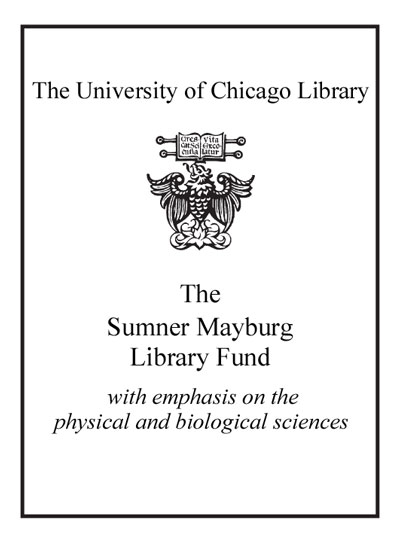Quantum field theory /
Saved in:
| Author / Creator: | Srednicki, Mark Allen. |
|---|---|
| Imprint: | Cambridge : Cambridge University Press, 2007. |
| Description: | xxi, 641 p. : ill. ; 26 cm. |
| Language: | English |
| Subject: | |
| Format: | Print Book |
| URL for this record: | http://pi.lib.uchicago.edu/1001/cat/bib/6234657 |
Table of Contents:
- Preface for students
- Preface for instructors
- Acknowledgements
- Part I. Spin Zero
- 1. Attempts at relativistic quantum mechanics
- 2. Lorentz invariance
- 3. Canonical quantization of scalar fields
- 4. The spin-statistics theorem
- 5. The LSZ reduction formula
- 6. Path integrals in quantum mechanics
- 7. The path integral for the harmonic oscillator
- 8. The path integral for free field theory
- 9. The path integral for interacting field theory
- 10. Scattering amplitudes and the Feynman rules
- 11. Cross sections and decay rates
- 12. Dimensional analysis with ?=c=1
- 13. The Lehmann-KÃñllÃ(c)n form
- 14. Loop corrections to the propagator
- 15. The one-loop correction in Lehmann-KÃñllÃ(c)n form
- 16. Loop corrections to the vertex
- 17. Other 1PI vertices
- 18. Higher-order corrections and renormalizability
- 19. Perturbation theory to all orders
- 20. Two-particle elastic scattering at one loop
- 21. The quantum action
- 22. Continuous symmetries and conserved currents
- 23. Discrete symmetries: P, T, C, and Z
- 24. Nonabelian symmetries
- 25. Unstable particles and resonances
- 26. Infrared divergences
- 27. Other renormalization schemes
- 28. The renormalization group
- 29. Effective field theory
- 30. Spontaneous symmetry breaking
- 31. Broken symmetry and loop corrections
- 32. Spontaneous breaking of continuous symmetries
- Part II. Spin One Half
- 33. Representations of the Lorentz Group
- 34. Left- and right-handed spinor fields
- 35. Manipulating spinor indices
- 36. Lagrangians for spinor fields
- 37. Canonical quantization of spinor fields I
- 38. Spinor technology
- 39. Canonical quantization of spinor fields II
- 40. Parity, time reversal, and charge conjugation
- 41. LSZ reduction for spin-one-half particles
- 42. The free fermion propagator
- 43. The path integral for fermion fields
- 44. Formal development of fermionic path integrals
- 45. The Feynman rules for Dirac fields
- 46. Spin sums
- 47. Gamma matrix technology
- 48. Spin-averaged cross sections
- 49. The Feynman rules for majorana fields
- 50. Massless particles and spinor helicity
- 51. Loop corrections in Yukawa theory
- 52. Beta functions in Yukawa theory
- 53. Functional determinants
- Part III. Spin One
- 54. Maxwell's equations
- 55. Electrodynamics in coulomb gauge
- 56. LSZ reduction for photons
- 57. The path integral for photons
- 58. Spinor electrodynamics
- 59. Scattering in spinor electrodynamics
- 60. Spinor helicity for spinor electrodynamics
- 61. Scalar electrodynamics
- 62. Loop corrections in spinor electrodynamics
- 63. The vertex function in spinor electrodynamics
- 64. The magnetic moment of the electron
- 65. Loop corrections in scalar electrodynamics
- 66. Beta functions in quantum electrodynamics
- 67. Ward identities in quantum electrodynamics I
- 68. Ward identities in quantum electrodynamics II
- 69. Nonabelian gauge theory
- 70. Group representations
- 71. The path integral for nonabelian gauge theory
- 72. The Feynman rules for nonabelian gauge theory
- 73. The beta function for nonabelian gauge theory
- 74. BRST symmetry
- 75. Chiral gauge theories and anomalies
- 76. Anomalies in global symmetries
- 77. Anomalies and the path integral for fermions
- 78. Background field gauge
- 79. Gervais-Neveu gauge
- 80. The Feynman rules for N x N matrix fields
- 81. Scattering in quantum chromodynamics
- 82. Wilson loops, lattice theory, and confinement
- 83. Chiral symmetry breaking
- 84. Spontaneous breaking of gauge symmetries
- 85. Spontaneously broken abelian gauge theory
- 86. Spontaneously broken nonabelian gauge theory
- 87. The standard model: Gauge and Higgs sector
- 88. The standard model: Lepton sector
- 89. The standard model: Quark sector
- 90. Electroweak interactions of hadrons
- 91. Neutrino masses
- 92. Solitons and monopoles
- 93. Instantons and theta vacua
- 94. Quarks and theta vacua
- 95. Supersymmetry
- 96. The minimal supersymmetric standard model
- 97. Grand unification
- Bibliography


